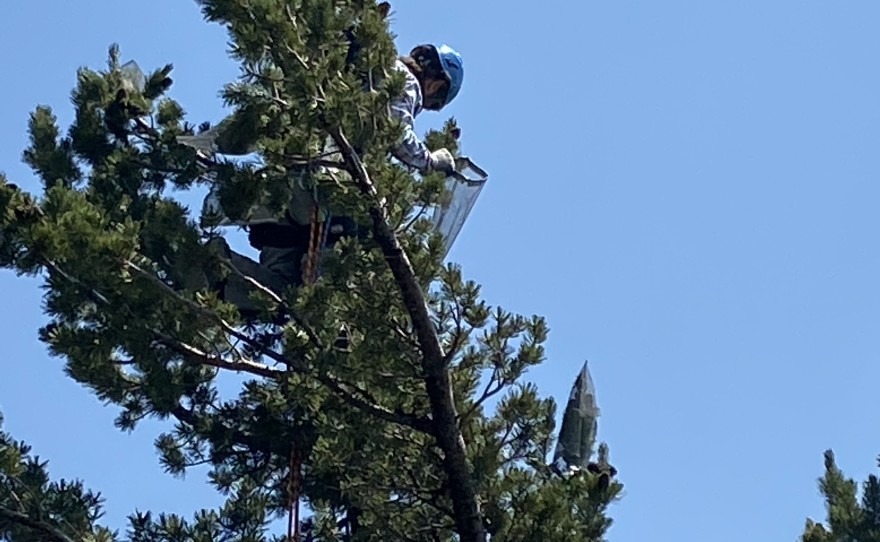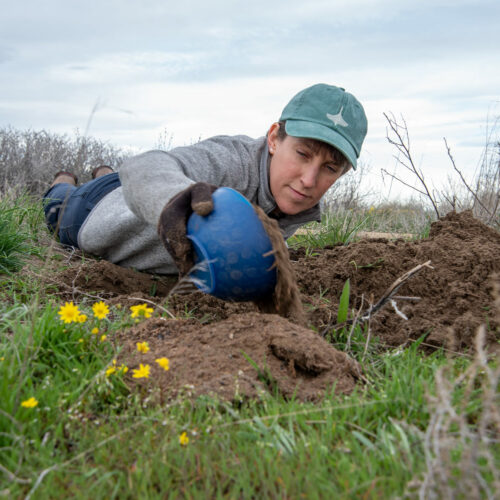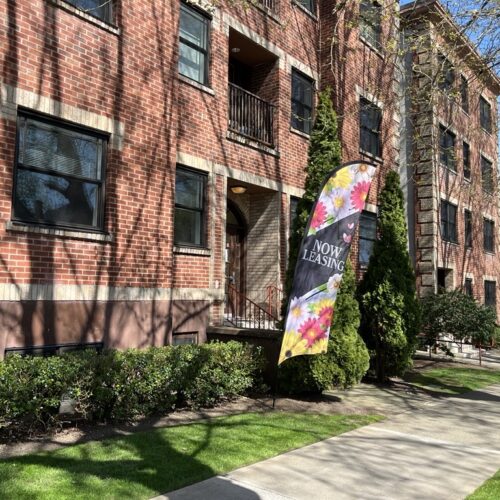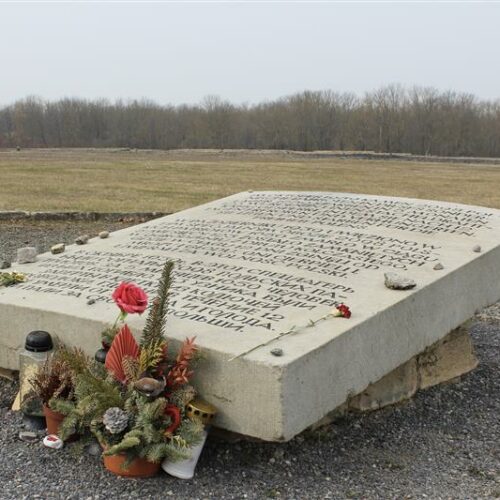Near a popular picnic site at Crater Lake National Park, whitebark pine trees provide a little shade. If you’re observant on this recent summer morning, you might notice something a little out of place.
In the treetops, at least 25 feet up, an orange helmet stands out against green pine needles. Look more closely, and there’s a person up there. He’s strapped to the tree, and he’s looking at pine cones on the tips of the branches.
“That tree’s got some good cones,” says tree climber Phil Chi, as he inspects another tree before heading up.
Chi and three other tree climbers are placing mesh cages around young, healthy cones.
Once he’s made it to the top, Chi counts the cones he puts in each cage. Someone on the ground records everything on paper.
“That’s four cones,” Chi calls out.
The goal is to cage at least 10 cones per tree.
It’s an effort to protect the cones from being eaten by Clark’s nutcrackers, which are birds that devour whitebark pine cones. They pick the cones apart to reach the seeds inside.
The nutcrackers are the main way whitebark pine seeds spread across high-elevation forests. But, researchers need to study these seeds.
“I think a clarkie got this one,” Chi says, as he drops the cone down for us to see.
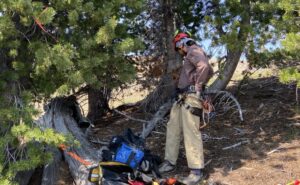
Tree climber Phil Chi does one last safety check before he climbs to the top of a whitebark pine tree.
“Headache,” he yells, a warning for those on the ground to step back. The clarkies have only eaten a few cones on this tree, he says.
These newly caged cones won’t become bird feed – as delicious and nutritious as they may be. The seeds are high in protein.
“They’re really good to eat,” says tree climber Brock Mayo.
“Really?” I ask. “How do you eat them?”
“Oh yeah,” Mayo says. “I eat them raw. You have to get the seed coat off. They’re like pine nuts you buy at the store. They’re one of my favorites.”
Large-scale effort to protect cones
Protecting cones on Crater Lake is part of a large-scale effort to save these important trees across the West, from the southern Sierra Nevadas, to the Colorado Rockies, to British Columbia. They face a growing list of threats: climate change, mountain pine beetles, and, now, white pine blister rust, a fungal disease that’s caused by an invasive pathogen.
The U.S. Forest Service says whitebark pine deaths are happening faster than the trees can grow. A recent study found 51% of all standing whitebark pine trees in the United States were dead.
Researchers will study the baby trees that sprout from these seeds. If they prove resistant to blister rust, they could help restore whitebark pine stands throughout the Northwest.
This year, Crater Lake National Park has funding to cage cones on 17 new trees. Before this season, the park had collected cones from 126 trees, according to the conservation program’s 2018 annual report. That rust-resistance screening started in 2003.
Jen Hooke, a park botanist, first spotted these iconic trees as she backpacked in California’s high mountains.
“This is the quintessential wilderness tree species. It goes up to the treeline. So, anytime you’re out in the wilderness, anytime you’re in the West at a high mountain lake, you’re likely spending your time with whitebark pine,” Hooke says.
If you’ve been to Crater Lake, you’ve definitely stumbled upon the trees – whether or not you realized it. One of the only ADA-accessible tree restoration projects in the country is planted at the heavily trafficked Rim Village tourist area. The trees were planted in 2009. Around 80% have survived so far.
After changing the site from a parking lot into a tree restoration area, “The soils are a little bit compacted. The harder soils have slowed the recolonization by the pocket gophers,” Hooke says.
Small mammals like to eat the seedlings in the wild. Pocket gophers have gotten to some of the restoration trees at Rim Village. Some of the trees are showing signs of blister rust.
Whitebark pines are an integral part of the park, Hooke says.
“I think it would be an empty, sad place without whitebark pine,” she says. “This is the highest mountain in the park, Mount Scott, in front of us here. The primary tree cover is whitebark pine. You can see the mountain hemlock, which are the pointy crowns, and the whitebark, which are rounder. Imagine all of that devoid of trees. It would be a huge change.”
It’s not just the views whitebark pine make whole. It’s the entire ecosystem. Diana Tomback has made a career of whitebark pine research (initially by way of studying the clarkies that feast upon their cones).
Whitebark pines are what are known in ecological circles as a keystone species, for the many benefits the trees provide.
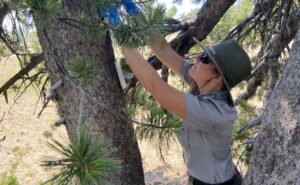
Crater Lake botanist Jen Hooke staples pouches of the pheromone verbenone to fend off mountain bark beetles. That should protect whitebark pine trees she’s studying from the beetles.
“(Whitebark pine is) providing a food resource, for example, and a lot of different birds and small mammals that will use the seeds. It’s protecting snowpack, which leads to more consistent downstream flow – that’s incredibly critical during this time of climate change,” says Tomback, a professor at the University of Colorado Denver. “We want to keep these right? They’re a part of our heritage and just critical to the natural world and its function.”
These trees aren’t sold as timber, so research first started on other blister-rust susceptible five-needle pine trees, such as western white pine. To help fill that gap, the Whitebark Pine Ecosystem Foundation, which Tomback previously led, has advocated for the trees since 2001.
The trees have needed a Seusian-style Lorax to help with the multiple challenges they face. In the 1980s, Tomback says there wasn’t enough fire on the landscape. Whitebark pine habitat, high up on the mountain tops, was crowded by more shade-tolerant trees.
Now, there’s too much fire in some places. Wildfires have become larger and burn hotter, instead of the restorative burns these ecosystems need. That can kill entire whitebark pine stands. The Washington Department of Natural Resources has helped replant some of these severely burned areas with experimental seedlings they hope have some resistance to blister rust.
Blister rust threat
Climate change is heating up the mountain slopes, and other heat-tolerant trees are climbing higher in elevation, further crowding whitebark habitat.
“All these things coming together are really hitting whitebark pine hard,” Tomback says.
Now, she says, blister rust has become the trees’ biggest threat.
“The bad thing about blister rust is that it infects all ages from seedlings all the way up to mature – even centuries old – trees. It can take a little longer to kill a large tree, but once a tree has a major blister rust canker, and that canker gets in the trunk of the tree, that tree will die,” Tomback says.
Wind carries blister rust spores to the far reaches of whitebark pine habitat. It can’t be contained.
“You might see a dead top at first, or old, dead branches,” says Brent Oblinger, a forest pathologist with the Forest Service.
Blister rust requires another host, like currants, scarlet paintbrushes or gooseberries. It can’t spread directly from pine to pine. The humidity and temperature have to be just right. Then the spores enter the whitebark pine through tiny pores in its needles. The spores travel into the branches and create cankers. If it makes it to the tree’s mainstem, it can girdle the tree. That blocks nutrients to the upper portion of the tree, starving it and leading to a slow death.
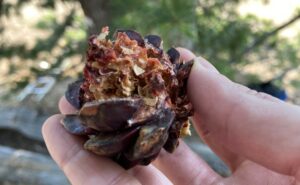
A whitebark pine cone that’s been eaten by a Clark’s nutcracker. The birds are the main why whitebark pine seeds are spread through high elevation forests.
“If you’re out at the right time, there’d be just these orange ‘sacks.’ Then they explode. The spores are just bright orange,” Mayo says. “You’re like, ‘Wow. That looks odd.’ But not really like pollen flying through the air, unless you individually pop (the sacks).”
Mayo was on the “blister rust crew” with the Dorena Genetic Resource Center in Cottage Grove.
“There’s way more of it than you think,” Mayo says. “I’d never heard of it. Once you start knowing what it looks like, it’s everywhere.
“This looks like a canker here,” he says, pointing to a limb directly behind him.
The Crater Lake cone-protecting team has selected trees that appear to be doing well, near trees that are fighting off blister rust infections. They hope the nearby healthy whitebark pines have a bit of resistance.
One major tool to help in the fight against blister rust is identifying and breeding trees with resistance.
Resistance to rust
At the Dorena Genetic Resource Center, Richard Sniezko has been screening whitebark pines for resistance to blister rust since 2002. (He started working at the center in 1991. The program had studied western white pines since about 1966.)
Sniezko takes the cones that have been harvested from places like Crater Lake. His team removes the seeds and then grows new seedling trees for two years. The researchers then try to infect the trees with blister rust.
They place trees in a fog chamber, which Sniezko jokes could be the world’s largest.
“It’s not even a mist. It’s a fine fog. You can hold your hand out at arm’s length, and you won’t even see your hand,” Sniezko says.
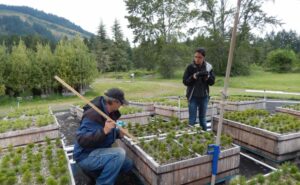
Dorena Genetic research Center technicians Bob Danchok and Kristin Silva take measurements of whitebark pine trees they’re studying.
There, he’s able to create the right temperature and humidity for the blister rust to fall from infected leaves onto the seedlings. Then they move trees outside and watch them for up to five years.
“With forest trees, the resistance we put out there has to last not five years. It has to last at least 100 years,” Sniezko says. “And, really, with whitebark pine it has to last forever. Because not only do you want those parents to be hundreds of years old, but they’re going to produce some progeny for the ensuing generations.”
Whitebark pines don’t reach full reproductive maturity until they are around 60 years old.
Other efforts have sequenced the whitebark pine genome, Tomback says. She hopes genomics could “fast track the identification of rust-resistant species.” Tomback says efforts at the Dorena Genetic Research Center that have already found rust-resistant trees will help identify key genes in future studies.
The team has screened nearly 1,500 trees throughout Oregon and Washington. Each tree is graded for its resistance to blister rust. (“A” shows the best resistance; “F” the worst, like in school. The program at Crater Lake plants trees that have received an “A,” “B” or “C” to promote genetic diversity.)
“The level of resistance we’re finding in whitebark pine from the wild trees is much higher for the most part than we ever found in the other species we’ve worked with. So we got lucky,” Sniezko says. “I think this is shaping up to be a real success story – and a great example of many people and organizations working together to help ameliorate a problem.”
Pining for whitebark in central Washington
Some of the resistant trees Sniezko has bred have been planted near the summit of Darland Mountain, more than an hour’s drive west of Yakima.
Dan Omdal is a forest pathologist with the Washington Department of Natural Resources. He realized he could help with whitebark pine restoration when he was moonlighting as a wildfire public information officer.
He heard the radios chattering away, as firefighters worked to protect whitebark stands. He remembered seedlings were available that needed to be planted.
“Two months later, we’re up on Hall Mountain (in the Colville National Forest of northeastern Washington) planting another research site to test these different (genetically resistant) families out in the environment,” Omdal says. “There’s not a lot of natural regeneration taking place in that burned area. (It will) hopefully provide some information on how well we’ve been doing, identifying families that we believe may have some strategies for resistance that might help them to at least tolerate the pathogen that is not going away.”
Now, the state DNR, working with the Forest Service and federal Bureau of Indian Affairs, has planted four sites to help test genetic resistance to blister rust.
Omdal walks around a stand burned in the Discovery Fire. Twelve years later, the area is starting to recover. Some whitebark pine that didn’t burn show signs of blister rust, large cankers choke tree limbs. Fungus pustules burst when poked.
“This upper portion of the tree has been dead for a really long time,” Omdal says. “You can see that there are these swollen, disfigured branches, but there are still branches beneath the infection court that allowed this tree to persist. And so it’s fighting as best it can.”
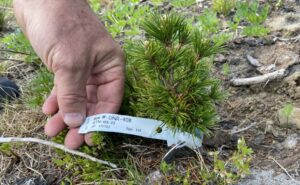
Washington Department of Natural Resources forest pathologist Dan Omdal reaches down to take a look at tiny whitebark pine seedlings he’s studying. These trees are 5 years old.
A short walk along the hillside, Omdal bends down to inspect some 5-year-old seedlings. The slow-growing trees are palm-sized. Researchers have picked this spot to test their genetic resistance to blister rust.
“It’s a harsh climate up here. You can see that the buds have just broken. So, this is the next cohort of needles,” Omdal says. “They’ve done remarkably well, actually. You don’t often expect such high levels of survival.”
They’ve planted about 1,000 seedlings on this site, from up to 30 different genetic “families.” They check the trees every year to look for signs of blister rust. So far, they haven’t been infected, but they’re still very small, Omdal says.
“You really want these seedlings to be exposed, early and often,” he says.
Tribes are also working to restore and protect whitebark pine stands. For the Confederated Salish and Kootenai Tribes, the seeds, known as sce ̌̓ yɫp, are considered a delicacy, as Tony Incashola told the Char-Koosta News.
He remembers eating the seeds as a boy.
“It was more like a treat. If you come across it in your travels it was a treat to have. I used to remember my Elders saying you can’t have more than a handful or you will pay for it later,” Incashola told the publication.
Now an Elder, Incashola says the trees and their seeds are harder to find.
At a workshop in 2017, a tribal culture committee documented the importance of the pines, saying Elders used to know where the trees were abundant.
“The threats to whitebark pine are therefore direct threats to our cultural ways. Sc ̌̓ iɫpálq͏ʷ (whitebark pine) is an important part of our subsistence, and therefore part of our connection to the mountains themselves,” the committee wrote.
Keeping an eye at Crater Lake
Back at Crater Lake, the tree climbers caged cones on 17 trees. The number of cones the team caged on each tree varied, from 12 to 135, Hooke says. They’ll come back to harvest the cones in October, once they’ve fully matured. It’ll take around seven years to fully determine whether these cones are resistant to blister rust.
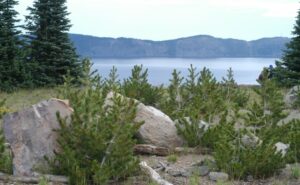
One of the only ADA-accessible tree restoration projects in the country is planned at the heavily trafficked Rim Village tourist area. Whitebark pines were planted in 2009. Around 80% have survived so far.
In the meantime, Jen Hooke will keep an eye on these trees. Today, she’s stapling pouches of the pheromone verbenone to fend off mountain bark beetles. It’d be bad news to have a potentially resistant tree felled by a different threat.
“(The bark beetles) communicate through pheromones. This is just a pheromone that says that the tree is fully colonized already,” Hooke says. “Really tricking them into thinking that there’s no vacancy here, so they’ll go elsewhere.”
At the park, researchers have found more trees than normal appear to be resistant to blister rust. That could be good news for stands across the Northwest.
“We do have some resistant trees here. I think some areas have like less than 5%, and our numbers are a little higher. So that’s promising,” Hooke says.
Hooke says along the Pacific Coast researchers have detected some genetic resistance in approximately 25% of whitebark pine populations. At Crater Lake, she estimates around 37.6% of the trees had some level of genetic resistance.
The federal government is considering adding whitebark pine to the Endangered Species List. It was first considered for listing in 2011 and remains a “candidate for species listing.” A decision is expected this December.

